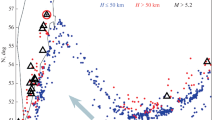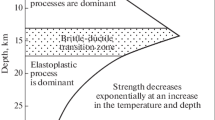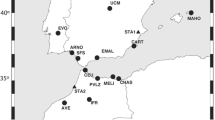Abstract
At the high pressures and temperatures typical of the Earth's interior, the brittle failure in accordance with the generally accepted Reid elastic rebound model cannot occur at depths greater than a few dozen kilometers. Nevertheless, earthquakes do occur at depths to about 700 km depth and some more. The paradox is explained by the presence of the deep fluid that decreases the effective friction in rocks and/or by metamorphic processes occurring in down-going slabs. These models imply an essential difference between characteristics of earthquakes occurring at different depth. However, no appreciable differences have so far been found between the source characteristics of the shallow, intermediate-depth, and the deep earthquakes. A few such differences are found and discussed below. Firstly, a few examples are presented demonstrating that the stress and tectonic deformations are not sufficient for the occurrence of earthquakes deeper than 30–50 km. An additional factor associated with metamorphic transformations appears to be required for the occurrence of deeper earthquakes. It is shown also that the typical values of a few source parameters of earthquakes (the normalized duration of seismic process, apparent stress, etc.) vary substantially over depth. What is more, these variations are consistent with suggested changes in mechanisms of earthquakes generation with the depth. The depth boundaries between different models of earthquakes origin are marked by increased median values of the apparent stresses and durations of seismic radiation process. “Normal” earthquakes can occur only in the upper 50 km of the lithosphere. The intermediate-depth earthquakes appear to be connected mainly with the dehydration embrittlement; the deep earthquakes appear to be connected with the solid-state (phase) transformations.






Similar content being viewed by others
References
Abe, K. (1982). Magnitude, seismic moment and apparent stress for major deep earthquakes. Journal of Physics of the Earth, 30(4), 321–330.
Baltay, A., Ide, S., Prieto, G., & Beroza, G. (2011). Variability in earthquake stress drop and apparent stress. Geophysical Research Letters, 38(6), L06303.
Bridgman, P. W. (1945). Polymorphic transitions and geological phenomena. American Journal of Science A, 243(1), 90–96.
Brodie, K. H., & Rutter, E. H. (1987). The role of transiently fine-grained reaction products in nontectonic metamorphism: Natural and experimental examples. Canadian Journal of Earth Sciences, 24(3), 556–564.
Ferrand, T. P., & Deldicque, D. (2021). Reduced viscosity of Mg2GeO4 with minor MgGeO3 between 1000 and 115 °C suggests solid-state lubrication at the lithosphere-asthenosphere boundary. Minerals, 11(6), 600. https://doi.org/10.3390/min11060600
Green, H. W., 2nd. (2017). Phase-transformation-induced lubrication of earthquake sliding. Philosophical Transactions of the Royal Society a: Mathematical Physical Engineering Sciences., A375(2103), 20160008. https://doi.org/10.1098/rsta.2016.0008
Greewood, G. W., & Johnson, R. H. (1965). The deformation of metals under stress during phase transformations. Proceedings of the Royal Society of London, 283, 403–422.
Griggs, D. T., & Handin, J. (1960). Observations on fracture and hypothesis of earthquakes. Geological Society of America. Memoirs., 79, 347–373.
Houston, H. (2015). Deep earthquakes. Treatise on geophysics (Vol. 4, 2nd edn, pp. 329–354).
Iidaka, T., & Furukawa, Y. (1994). Double seismic zone for deep earthquakes in the Izu-Bonin subduction zone. Science, 263(5150), 1116–1118.
Ito, E., & Sato, H. (1991). Aseismicity in the lower mantle by superplasticity of the descending slab. Nature, 351, 140–141.
Julian, B. R., Miller, A. D., & Foulger, G. R. (1998). Non-double-couple earthquakes 1. Theory. Reviews of Geophysics, 36(4), 525–549.
Kalinin, V. A., & Rodkin, M. V. (1982). Physical model of deep-focus earthquakes. Izvestiya AN SSSR, Physics of the Earth, 1982(8), 3–12. in Russian.
Kalinin, V. A., & Rodkin, M. V. (1989). The quantitative deep earthquakes model. High pressure investigations in geosciences (pp. 213–217). Academie-Verlag.
Kalinin, V. A., Rodkin, M. V., & Tomashevskaya, I. S. (1989). Geodynamic effects of physicochemical solid-state transformations. Nauka. in Russian.
Kirby, S. H. (1987). Localized polymorphic phase transformations in high-pressure faults and application to the physical mechanism of deep earthquakes. Journal Geophysical Research B., 92(13), 13789–13800.
Kirby, S. H., Durham, W. B., & Stern, L. A. (1991). Mantle phase changes and deep earthquake faulting in subducting litho- sphere. Science, 152, 216–225.
Kuskov, O. L., Fabrichnaya, O. B., & Truskinovsky, L. M. (1991). Constitution of the mantle. 2. Petrological models of transition zone based on FMS phase diagram. Physics of the Earth and Planetary Interiors., 69(1–2), 72–84.
Lachenbmch, A. H., & Sass, J. H. (1988). The stress heat-flow paradox and thermal results from Cajon Pass. Geophysical Research Letters., 15, 981–984.
Li, J., Zheng, Y., Thomsen, L., et al. (2018). Deep earthquakes in subducting slabs hosted in highly anisotropic rock fabric. Nature Geoscience., 11, 696–700. https://doi.org/10.1038/s41561-018-0188-3
Panasyuk, S. V., & Hager, B. H. (1998). A model of transformational superplasticity in the upper mantle. Geophysical Journal International., 133(3), 741–755. https://doi.org/10.1046/j.1365-246X.1998.00539.x
Poirier, J.-P. (1985). Creep of crystals. Cambridge earth science series (Vol. xiv, p. 260). London: Cambridge.
Rodkin, M. V., & Rundqvist, D. V. (2017). Geofluidodynamics. Application to seismology, tectonics, ore and oil genesis processes (p. 288). Dolgoprudny: Publishing House "Intellect" (in Russian).
Rodkin, M. V. (1995). Crustal earthquakes induced by solid-state transformations: A model and characteristic precursors. J. Earthquake Prediction Research., 4(2), 215–223.
Rodkin, M. V. (1996). Contradictions in the recent seismogical notions. Physics and Chemistry of the Earth., 21(4), 257–260.
Rubie, D. C. (1983). Reaction-enhanced ductility: The role of solid-solid reactions in the deformation of the crust and mantle. Tectonophysics, 96(3), 331–352.
Savage, J. C., Svarc, J. L., & Prescott, W. H. (1999). Geodetic estimates of fault slip rates in the San Francisco Bay area. Journal Geophysical Research, 104, 4995–5002.
Shirey, S. B., Wagner, L. S., Walter, M. J., Pearson, D. G., & Keken, P. E. (2021). Slab transport of fluids to deep focus earthquake depths—Thermal modeling constraints and evidence from diamonds. AGU Advances, 2(2), e2020AV000304. https://doi.org/10.1029/2020AV000304
Sornette, D. (1999). Earthquakes: From chemical alteration to mechanical rupture. Physics Reports, 313(5), 237–292. https://doi.org/10.1016/S0370-1573(98)00088-X
Wang, J., Zhao, D., & Yao, Z. (2017). Seismic anisotropy evidence for dehydration embrittlement triggering intermediate-depth earthquakes. Scientific Reports, 7, 2613. https://doi.org/10.1038/s41598-017-02563-w
Zheng, Y. F., Chen, R. X., Xu, Z., & Zhang, S. B. (2016). The transport of water in subduction zones. Science China Earth Sciences, 59, 651–682.
Zulian, M. (2021). A fluid’s journey into deep earth may explain deep quakes. Temblor. https://doi.org/10.32858/temblor.183
Acknowledgements
This study was carried out under the state task of the Institute of Earthquake Prediction Theory and Mathematical Geophysics, Russian Academy of Sciences), and the Institute of Marine Geology and Geophysics, Far East Branch, Russian Academy of Sciences, and Oil and Gas Research Institute, Russian Academy of Sciences, with partial support by the Russian Foundation for Basic Research (project no. 19-05-00466).
Funding
Funding was provided by RFBR (Project No. 19-05-00466).
Author information
Authors and Affiliations
Corresponding author
Additional information
Publisher's Note
Springer Nature remains neutral with regard to jurisdictional claims in published maps and institutional affiliations.
Rights and permissions
About this article
Cite this article
Rodkin, M.V. The Variability of Earthquake Parameters with the Depth: Evidences of Difference of Mechanisms of Generation of the Shallow, Intermediate-Depth, and the Deep Earthquakes. Pure Appl. Geophys. 179, 4197–4206 (2022). https://doi.org/10.1007/s00024-021-02927-4
Received:
Revised:
Accepted:
Published:
Issue Date:
DOI: https://doi.org/10.1007/s00024-021-02927-4




